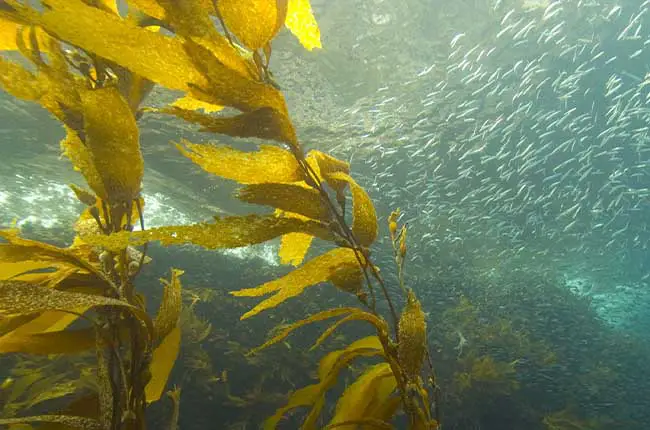While kelp may be a familiar term, its benefits for home gardens, particularly for struggling orchids, are lesser-known.
How is kelp or seaweed beneficial for orchids?
Kelp or seaweed extract is an excellent organic stimulant for plant growth. It is not a fertilizer but a rich source of growth hormones, especially auxin for root growth. An increased root mass means better moisture and nutrient uptake, leading to more foliage, flowers and resistance to stress.
Kelp vs seaweed fertilizer: Any difference?
Seaweed is a general term to describe any marine-based plant and algae. Kelp is more specific and is the largest subgroup of seaweed. Kelp grows in tidal zones exposed to temperature extremes, flooding and drought, high levels of salt, and solar radiation.
When made into a product for supplementing plant growth, kelp from different waters varies in quality and effect. One of the best types of kelp is Ecklonia Maxima which grows in large underwater forests off the coast of South Africa.
When people talk about “kelp fertilizer” and “seaweed fertilizer”, most people use the terms synonymously.
But, strictly speaking, kelp or seaweed extract is not a fertilizer, but a potion of growth hormones. More about this later.
Benefits of kelp or seaweed for orchids
Liquid kelp or seaweed is an excellent supplement for all plant growth.
For orchids, it has proven phenomenal success in producing:
- Thicker, healthy roots
- Robust new root growth and lateral growth on old roots (important especially for rootless orchids)
- Increased plant size
- Increased resistance against some diseases, temperature changes, drought, and waterlogged situations
- More flower spikes
- Better flower quality and color
- Stronger flower fragrance

How does kelp or seaweed do that? Here is the science behind it.
Kelp or seaweed is rich in plant hormones, especially auxins, cytokinins, gibberellins, and beneficial micro-nutrients.
Auxin and cytokinin are actually produced by all plants in their natural growth. When shoots grow, the buds (growth tips) produce the plant hormone, auxin, which would travel down to the roots to stimulate root growth.
When roots grow, the root tips would subsequently produce cytokinin which would travel up to trigger shoot growth to promote cell division. It is a natural back-and-forth cycle.
When we apply plant hormones to a plant, it would boost one of the processes and in turn boost the other, resulting in overall increases in plant growth.
Gibberellin also serves an important role in stem elongation, leaf expansion, and flower development.
Therefore, kelp or seaweed extract that is rich in auxin is basically a rooting hormone or stimulator. With more roots, there will also be an increase in moisture and nutrient uptake. This would then result in a bigger, stronger plant with more foliage, better flowers, and better resistance to stress.
Best seaweed extract for plant growth
There are many seaweed and kelp fertilizer brands in the market. But not all kelp products are the same in quality and effects. Look for pure kelp and seaweed extracts, such as “Bloom City” Kelp and Seaweed extract.

There are three reasons why this product is the most superior.
- First, the product extracts natural plant hormones from 7 kelp species which are harvested off the coasts, rather than hormones synthetically produced in laboratories.
- Also, the product contains a high ratio of auxin to cytokinin, whereas the other brands contain a high level of cytokinin. The problem with a high level of cytokinin is that it would stimulate predominantly shoot growth whereas root growth would just be secondary. This would result in “leggy” plants with not much root support and making the plant more vulnerable to root burn, some diseases, nutrient deficiency, temperature and environmental stresses.
- Another highlight is that it has a long shelf life, much greater than liquid synthetic hormone products on the market. If kept tightly sealed between uses in a cool location away from direct sunlight, the product can be used for at least two years.
Can liquid kelp cause root burn?
A pure kelp or seaweed extract will not cause root burn because it is not a fertilizer, but primary plant hormones.
Some kelp extracts in the market may, however, cause root burn in case of overdose as there are nitrogen (N), phosphorous (P) and potassium (K) nutrients added.
How to feed orchids with kelp: Warning!
Since kelp or seaweed extract is plant hormones, some precautions must be taken in the application:
- Apply kelp or seaweed extract once per month as part of the fertilization routine. This is because the cycle of root and shoot growth subsides to normal levels in about 3 weeks after the application of hormones.
- Be careful not to overdose the seaweed extract. Only a small amount of auxin is needed to initiate root growth. The recommended dosage is 1 tbsp per gallon of water.
An overdose of auxins can lead to deformed flowers, stunted growth or even death. The herbicide 2,4-D, is an auxin that stimulates plants to death.
Conclusion
To sum up, kelp or seaweed extract is an excellent organic supplement rich in plant hormones, especially auxin in stimulating root growth and cytokinin for shoot growth. An increased root mass also means an increase in moisture and nutrient uptake, resulting in a bigger, stronger plant with more foliage, better flowers and better resistance to stress. But, caution must be taken to avoid overdosing which can stimulate plants to death.
Tell your friends!
Sources
Smith, H. (2010). Seaweed Extracts and Plant Growth Hormones. Innovation in Horticulture. Hydrodynamics international (Spring).
First Rays. KelpMax Kelp Extract
Related Articles
Orchid Nutrition and Fertilizer: A Complete Guide
Coffee As Orchid Fertilizer? (Don’t Do This!)
Featured image credit:
“Kelp and Sardines” by NOAA’s National Ocean Service is licensed under CC BY 2.0
- Keiki Paste vs Rooting Hormone:What’s the difference? - February 4, 2024
- Top 10 Orchid Fertilizers: A Comprehensive Review (2024) - February 2, 2024
- Top 8 Soil Inoculants For Stronger Plants (2024) - February 1, 2024


